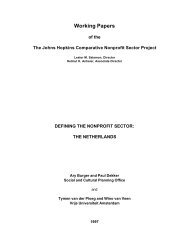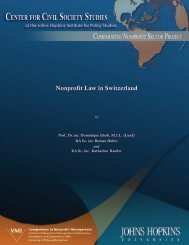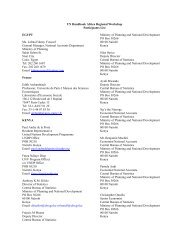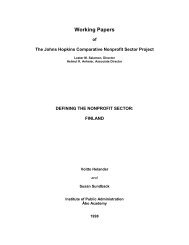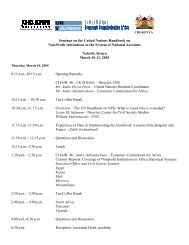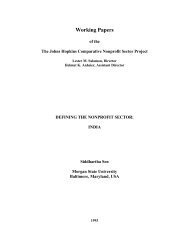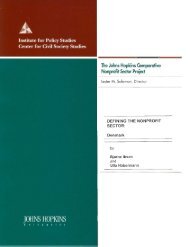Campetella, González Bombal, and Roitter<strong>Defining</strong> <strong>the</strong> <strong>Nonprofit</strong> <strong>Sector</strong>: <strong>Argentina</strong>capable of granting <strong>the</strong>m legal status. It also established legal exemptions regarding mutualassociations, stating that <strong>the</strong>y are exempt from all taxes concerning <strong>the</strong>ir goods or activities and taxesrelating to <strong>the</strong> import of machinery, medical instruments, drugs or any o<strong>the</strong>r element <strong>the</strong>y may usewhen providing <strong>the</strong>ir services. Likewise, <strong>the</strong> interest on <strong>the</strong> associates’ contributions is exempt fromincome taxes.Currently <strong>the</strong>re are more than 6,000 mutual associations, with a membership ofapproximately 5 million, and lending different kind of social services to <strong>the</strong>ir communities. Most of<strong>the</strong>m operate in <strong>the</strong> insurance, social security, credit, housing, health care and consumption fields.CooperativesCooperatives also emerged at <strong>the</strong> end of <strong>the</strong> 19 th century, alongside immigration, expansionof <strong>the</strong> working class and economic development. If mutual organizations were an urbanphenomenon, cooperatives started as a rural phenomenon by which settlers and farmers organized<strong>the</strong>ir agricultural activity. Gradually, cooperatives expanded beyond agriculture to o<strong>the</strong>r fields suchas credit, insurance, housing and employment. Above all, <strong>the</strong>y developed in <strong>the</strong> provinces to providebasic needs, such as utilities, in areas that were unattractive for profit-seeking businesses.The current Law on Cooperatives was enacted in 1973, after a precedent set in 1926 when <strong>the</strong>first law on cooperative societies was enacted. As in <strong>the</strong> case of mutual benefit societies, <strong>the</strong> Law of1973 withdrew cooperatives from <strong>the</strong> control of <strong>the</strong> General Justice Inspection, establishing <strong>the</strong>National Institute of Cooperative Action (INAC) 16 as <strong>the</strong> only national public agency dealing withcooperatives and capable of granting <strong>the</strong>m legal status.While <strong>the</strong> Organic Law of Mutual Associations literally defines <strong>the</strong>m as nonprofitorganizations, fur<strong>the</strong>r clarifications and stipulations need to be made with regards to cooperatives.The Law on Cooperatives primarily defines <strong>the</strong>m as “legal entities founded on mutual effortand mutual help to organize and lend services.” Hence, in <strong>the</strong> first place <strong>the</strong> law highlights <strong>the</strong>service function performed by <strong>the</strong>se institutions. Likewise, <strong>the</strong> cooperative act is defined as “an actthat does not imply profitable exchange but <strong>the</strong> provision of a social service.” And finally, whendefining <strong>the</strong> social objective of cooperatives, <strong>the</strong> Law states that it consists in “<strong>the</strong> organization andprovision of a community service for <strong>the</strong> benefit of all <strong>the</strong> associates.”That being said, <strong>the</strong> most complex issue concerning <strong>the</strong> definition of cooperatives asnonprofit organizations is <strong>the</strong> actual possibility of distributing benefits among <strong>the</strong> associates.Regarding this issue, we must take into account <strong>the</strong> specific nature of cooperatives –i.e., <strong>the</strong> fact that<strong>the</strong>y belong to what is called economie sociale (social economy or solidarity economy)– thatestablishes some particularities regarding <strong>the</strong> definition of surplus and <strong>the</strong> way in which it can bedistributed.16In 1996 <strong>the</strong> INAM and <strong>the</strong> INAC merged, constituting <strong>the</strong> INACyM, as <strong>the</strong> only national public agency thatregulates cooperatives and mutual benefit associations.15
Campetella, González Bombal, and Roitter<strong>Defining</strong> <strong>the</strong> <strong>Nonprofit</strong> <strong>Sector</strong>: <strong>Argentina</strong>According to experts in this field, cooperatives can not be considered for-profit organizationsas <strong>the</strong>y do not distribute benefits <strong>the</strong> way for-profits do. Since <strong>the</strong> objective of cooperatives is toorganize and lend services, it is considered that <strong>the</strong> distributable surplus is that which stems from <strong>the</strong>difference between <strong>the</strong> cost and <strong>the</strong> price of <strong>the</strong> service lent. Thus, <strong>the</strong> origin of this surplus isdefined as “an excess in <strong>the</strong> estimate of <strong>the</strong> cost of <strong>the</strong> service provided.”If it is <strong>the</strong> case that this surplus is generated, 5 percent has to be deposited in a reserveaccount, 5 percent in an assistance and work fund, and 5 percent in an education and training fund.Regarding interest on capital, it can be paid only if <strong>the</strong> bylaws allow for it. 17 Once <strong>the</strong>se deductionshave been made, <strong>the</strong> remaining surplus can be distributed among <strong>the</strong> associates under <strong>the</strong> concept ofretorno (return), and in proportion to <strong>the</strong>ir use of <strong>the</strong> social service provided by <strong>the</strong> cooperative.In o<strong>the</strong>r words, <strong>the</strong> surplus generated by cooperative activity can be appropriated by <strong>the</strong>associates, once <strong>the</strong> deductions described are made, and bearing in mind <strong>the</strong> principle that <strong>the</strong>amounts to be distributed as retornos are mere “excesses in <strong>the</strong> estimate of <strong>the</strong> price of <strong>the</strong> serviceprovided.” Likewise, <strong>the</strong> surplus stemming from <strong>the</strong> provision of services to non-associates andfrom extraordinary economic operations, toge<strong>the</strong>r with <strong>the</strong> mentioned 5 percent, has to be placed in areserve account which cannot be distributed for any reason. Cooperative doctrine has denominatedthis non-distributional condition of reserves as “altruistic allocation of <strong>the</strong> patrimony,” which isfounded on <strong>the</strong> rigorous principle of preventing any associate from obtaining profits at any o<strong>the</strong>rperson’s expense –associate or non-associate–within <strong>the</strong> cooperative. If <strong>the</strong> cooperative is dissolved,<strong>the</strong> state is <strong>the</strong> only heir for this reserve account.Therefore, a crucial difference between cooperatives and for-profit organizations is thatcooperatives have limited possibilities of increasing <strong>the</strong>ir capital, owing to <strong>the</strong> fact that it does notincrease according to <strong>the</strong> profits obtained. That is, <strong>the</strong> capital is a means provided by <strong>the</strong> associatesto allow <strong>the</strong> cooperative to deliver efficient services for <strong>the</strong>mselves. Moreover, <strong>the</strong> capital isconstituted by social contributions that adopt <strong>the</strong> form of equal value nominative shares, which arenot divisible and grant <strong>the</strong> same rights to all <strong>the</strong> associates. Ano<strong>the</strong>r crucial difference lies in <strong>the</strong>concept of retorno and its distribution according to <strong>the</strong> use of social services made by each associateand not in proportion to <strong>the</strong>ir capital contribution. And finally, <strong>the</strong>re is <strong>the</strong> reserve account of nondistributionalcharacter, which is made up by <strong>the</strong> surplus generated by cooperative operations outsideof <strong>the</strong> lending of services to <strong>the</strong> associates.In conclusion, according to <strong>the</strong> experts and bearing in mind <strong>the</strong> specificity of cooperativedoctrine, we think it would be legitimate to consider cooperatives as nonprofit organizations. In thissense, experts on <strong>the</strong> economie sociale share this consideration, and describe cooperatives asinstitutions with <strong>the</strong> following features: nonprofit aim, democratic administration, and independencefrom <strong>the</strong> state (Hengstenberg and Cracogna, 1988).However, it is necessary to distinguish <strong>the</strong> different types of cooperatives that exist nowadaysin <strong>Argentina</strong>, as it is true that not all of <strong>the</strong>m fully meet <strong>the</strong> criteria to be considered nonprofit17On <strong>the</strong> o<strong>the</strong>r hand, if it is <strong>the</strong> case that such interest is paid, it is limited by <strong>the</strong> law to a rate lower than that paid by<strong>the</strong> National Bank.16
- Page 1 and 2: Working PapersofThe Johns Hopkins C
- Page 3 and 4: PREFACEThis is one in a series of W
- Page 5 and 6: Campetella, González Bombal, and R
- Page 7 and 8: Campetella, González Bombal, and R
- Page 9 and 10: Campetella, González Bombal, and R
- Page 11 and 12: Campetella, González Bombal, and R
- Page 13 and 14: Campetella, González Bombal, and R
- Page 15 and 16: Campetella, González Bombal, and R
- Page 17: Campetella, González Bombal, and R
- Page 21 and 22: Campetella, González Bombal, and R
- Page 23 and 24: Campetella, González Bombal, and R
- Page 25 and 26: Campetella, González Bombal, and R
- Page 27 and 28: Campetella, González Bombal, and R
- Page 29 and 30: Campetella, González Bombal, and R
- Page 31 and 32: Campetella, González Bombal, and R
- Page 33: Campetella, González Bombal, and R



